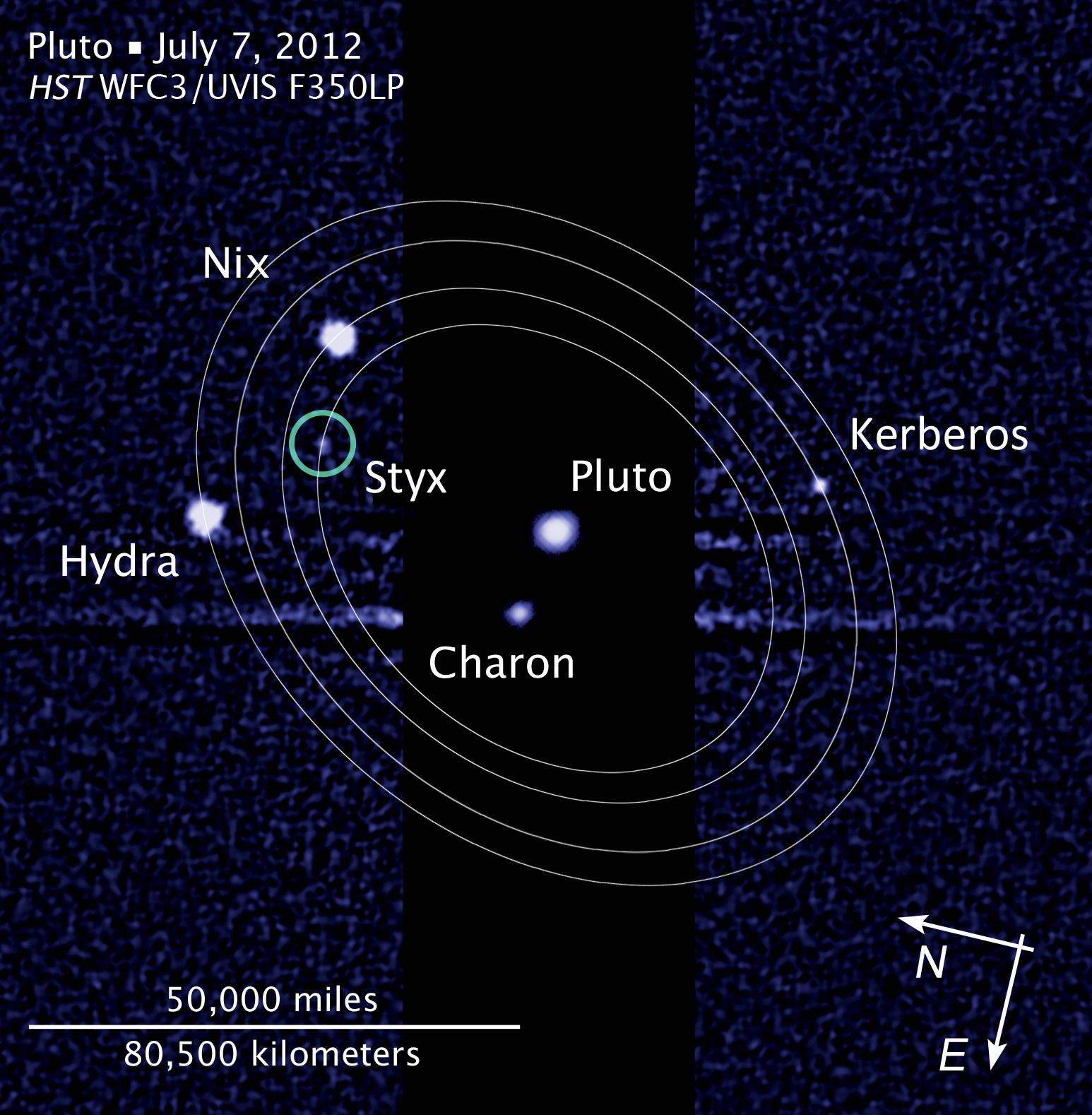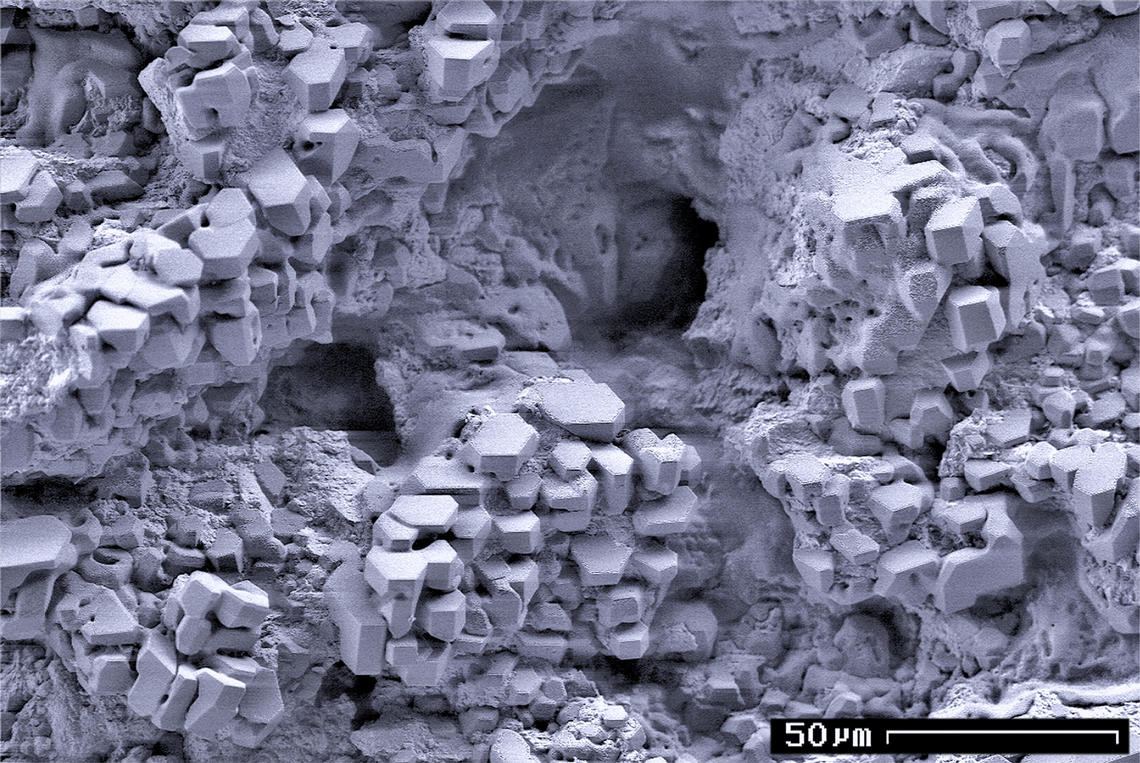|
Styx (moon)
Styx is a small natural satellite of Pluto whose discovery was announced on 11 July 2012. It was discovered by use of the Hubble Space Telescope. It is the second smallest moon of Pluto after Kerberos. It was imaged along with Pluto and Pluto's other moons by the ''New Horizons'' spacecraft in July 2015, albeit poorly with only a single image of Styx obtained. Styx is the second-closest known satellite to Pluto, and the fifth discovered. It was discovered one year after Kerberos. Styx is approximately across its longest dimension, and its orbital period is 20.1 days. Discovery and observations Styx was discovered by a team led by astronomer Mark R. Showalter, using fourteen sets of images taken between 26 June and 9 July 2012 by the Wide Field Camera 3 fitted to the Hubble. The discovery was announced on 11 July 2012. Styx is about half as bright as the dimmest previously known object in the system, Kerberos, and about one hundred thousandth as bright as Pluto. It was d ... [...More Info...] [...Related Items...] OR: [Wikipedia] [Google] [Baidu] |
New Horizons
''New Horizons'' is an Interplanetary spaceflight, interplanetary space probe that was launched as a part of NASA's New Frontiers program. Engineered by the Johns Hopkins University Applied Physics Laboratory (APL) and the Southwest Research Institute (SwRI), with a team led by Alan Stern, the spacecraft was launched in 2006 with the primary mission to perform a Planetary flyby, flyby study of the Pluto system in 2015, and a secondary mission to fly by and study one or more other Kuiper belt objects (KBOs) in the decade to follow, which became a mission to 486958 Arrokoth. It is the List of artificial objects leaving the Solar System, fifth space probe to achieve the escape velocity needed to leave the Solar System. On January 19, 2006, ''New Horizons'' was launched from Cape Canaveral Space Force Station by an Atlas V rocket directly into an Earth-and-solar Escape velocity, escape trajectory with a speed of about . It was the fastest (average speed with respect to Earth) man ... [...More Info...] [...Related Items...] OR: [Wikipedia] [Google] [Baidu] |
Giant Impact Hypothesis
The giant-impact hypothesis, sometimes called the Big Splash, or the Theia Impact, suggests that the Moon formed from the ejecta of a collision between the proto-Earth and a Mars-sized planet, approximately 4.5 billion years ago, in the Hadean eon (about 20 to 100 million years after the Solar System coalesced). The colliding body is sometimes called Theia, from the name of the mythical Greek Titan who was the mother of Selene, the goddess of the Moon. Analysis of lunar rocks, published in a 2016 report, suggests that the impact might have been a direct hit, causing a thorough mixing of both parent bodies. The giant-impact hypothesis is currently the favored scientific hypothesis for the formation of the Moon. Supporting evidence includes: * Earth's spin and the Moon's orbit have similar orientations. * The Earth–Moon system contains an anomalously high angular momentum. Meaning, the momentum contained in Earth's rotation, the Moon's rotation, and the Moon revolving aro ... [...More Info...] [...Related Items...] OR: [Wikipedia] [Google] [Baidu] |
Orbital Resonance
In celestial mechanics, orbital resonance occurs when orbiting bodies exert regular, periodic gravitational influence on each other, usually because their orbital periods are related by a ratio of small integers. Most commonly, this relationship is found between a pair of objects (binary resonance). The physical principle behind orbital resonance is similar in concept to pushing a child on a swing, whereby the orbit and the swing both have a natural frequency, and the body doing the "pushing" will act in periodic repetition to have a cumulative effect on the motion. Orbital resonances greatly enhance the mutual gravitational influence of the bodies (i.e., their ability to alter or constrain each other's orbits). In most cases, this results in an ''unstable'' interaction, in which the bodies exchange momentum and shift orbits until the resonance no longer exists. Under some circumstances, a resonant system can be self-correcting and thus stable. Examples are the 1:2:4 resonance ... [...More Info...] [...Related Items...] OR: [Wikipedia] [Google] [Baidu] |
Matryoshka Doll
Matryoshka dolls ( ; rus, матрёшка, p=mɐˈtrʲɵʂkə, a=Ru-матрёшка.ogg), also known as stacking dolls, nesting dolls, Russian tea dolls, or Russian dolls, are a set of wooden dolls of decreasing size placed one inside another. The name ''matryoshka'', mainly known as "little matron", is a diminutive form of ''Matryosha'' (), in turn a diminutive of the Russian female first name ''Matryona'' (). A set of matryoshkas consists of a wooden figure, which separates at the middle, top from bottom, to reveal a smaller figure of the same sort inside, which has, in turn, another figure inside of it, and so on. The first Russian nested doll set was made in 1890 by wood turning craftsman and wood carver Vasily Zvyozdochkin from a design by Sergey Malyutin, who was a folk crafts painter at Abramtsevo. Traditionally the outer layer is a woman, dressed in a sarafan, a long and shapeless traditional Russian peasant jumper dress. The figures inside may be of any gender; ... [...More Info...] [...Related Items...] OR: [Wikipedia] [Google] [Baidu] |
Hydra (moon)
Hydra is a natural satellite of Pluto, with a diameter of approximately across its longest dimension. It is the second-largest moon of Pluto, being slightly larger than Nix. Hydra was discovered along with Nix by astronomers using the Hubble Space Telescope on 15 May 2005, and was named after the Hydra, the nine-headed underworld serpent in Greek mythology. By distance, Hydra is the fifth and outermost moon of Pluto, orbiting beyond Pluto's fourth moon Kerberos. Hydra has a highly reflective surface caused by the presence of water ice, similar to other Plutonian moons. Hydra's reflectivity is intermediate, in between those of Pluto and Charon. The ''New Horizons'' spacecraft imaged Pluto and its moons in July 2015 and returned multiple images of Hydra. Discovery Hydra was discovered by researchers of the Pluto Companion Search Team, consisting of Hal A. Weaver and many others involved in the ''New Horizons'' mission to Pluto, including Alan Stern and Marc W. Buie. ... [...More Info...] [...Related Items...] OR: [Wikipedia] [Google] [Baidu] |
Nix (moon)
Nix is a natural satellite of Pluto, with a diameter of across its longest dimension. It was discovered along with Pluto's outermost moon Hydra on 15 May 2005 by astronomers using the Hubble Space Telescope, and was named after Nyx, the Greek goddess of the night. Nix is the third moon of Pluto by distance, orbiting between the moons Styx and Kerberos. Nix was imaged along with Pluto and its other moons by the ''New Horizons'' spacecraft as it flew by the Pluto system in July 2015. Images from the ''New Horizons'' spacecraft reveal a large reddish area on Nix that is likely an impact crater. Discovery Nix was discovered by researchers of the Pluto Companion Search Team, using the Hubble Space Telescope. The ''New Horizons'' team had suspected that Pluto and its moon Charon might be accompanied with other moons, hence they used the Hubble Space Telescope to search for faint moons around Pluto in 2005. Since Nix's brightness is about 5,000 times fainter than Pluto, ... [...More Info...] [...Related Items...] OR: [Wikipedia] [Google] [Baidu] |
Charon (moon)
Charon ( or ), known as (134340) Pluto I, is the largest of the five known natural satellites of the dwarf planet Pluto. It has a mean radius of . Charon is the sixth-largest known trans-Neptunian object after Pluto, Eris, Haumea, Makemake and Gonggong. It was discovered in 1978 at the United States Naval Observatory in Washington, D.C., using photographic plates taken at the United States Naval Observatory Flagstaff Station (NOFS). With half the diameter and one eighth the mass of Pluto, Charon is a very large moon in comparison to its parent body. Its gravitational influence is such that the barycenter of the Plutonian system lies outside Pluto, and the two bodies are tidally locked to each other. The reddish-brown cap of the north pole of Charon is composed of tholins, organic macromolecules that may be essential ingredients of life. These tholins were produced from methane, nitrogen and related gases which may have been released by cryovolcanic eruptions on the moon, o ... [...More Info...] [...Related Items...] OR: [Wikipedia] [Google] [Baidu] |
Ecliptic
The ecliptic or ecliptic plane is the orbital plane of the Earth around the Sun. From the perspective of an observer on Earth, the Sun's movement around the celestial sphere over the course of a year traces out a path along the ecliptic against the background of stars. The ecliptic is an important reference plane and is the basis of the ecliptic coordinate system. Sun's apparent motion The ecliptic is the apparent path of the Sun throughout the course of a year. Because Earth takes one year to orbit the Sun, the apparent position of the Sun takes one year to make a complete circuit of the ecliptic. With slightly more than 365 days in one year, the Sun moves a little less than 1° eastward every day. This small difference in the Sun's position against the stars causes any particular spot on Earth's surface to catch up with (and stand directly north or south of) the Sun about four minutes later each day than it would if Earth did not orbit; a day on Earth is therefore 24 hours ... [...More Info...] [...Related Items...] OR: [Wikipedia] [Google] [Baidu] |
Barycenter
In astronomy, the barycenter (or barycentre; ) is the center of mass of two or more bodies that orbit one another and is the point about which the bodies orbit. A barycenter is a dynamical point, not a physical object. It is an important concept in fields such as astronomy and astrophysics. The distance from a body's center of mass to the barycenter can be calculated as a two-body problem. If one of the two orbiting bodies is much more massive than the other and the bodies are relatively close to one another, the barycenter will typically be located within the more massive object. In this case, rather than the two bodies appearing to orbit a point between them, the less massive body will appear to orbit about the more massive body, while the more massive body might be observed to wobble slightly. This is the case for the Earth–Moon system, whose barycenter is located on average from Earth's center, which is 75% of Earth's radius of . When the two bodies are of similar mass ... [...More Info...] [...Related Items...] OR: [Wikipedia] [Google] [Baidu] |
Methane Clathrate
Methane clathrate (CH4·5.75H2O) or (8CH4·46H2O), also called methane hydrate, hydromethane, methane ice, fire ice, natural gas hydrate, or gas hydrate, is a solid clathrate compound (more specifically, a clathrate hydrate) in which a large amount of methane is trapped within a crystal structure of water, forming a solid similar to ice. Originally thought to occur only in the outer regions of the Solar System, where temperatures are low and water ice is common, significant deposits of methane clathrate have been found under sediments on the ocean floors of the Earth. Methane hydrate is formed when hydrogen-bonded water and methane gas come into contact at high pressures and low temperatures in oceans. Methane clathrates are common constituents of the shallow marine geosphere and they occur in deep Sedimentary rock, sedimentary structures and form outcrops on the ocean floor. Methane hydrates are believed to form by the precipitation or crystallisation of methane migrating from d ... [...More Info...] [...Related Items...] OR: [Wikipedia] [Google] [Baidu] |
Nitrogen
Nitrogen is the chemical element with the symbol N and atomic number 7. Nitrogen is a nonmetal and the lightest member of group 15 of the periodic table, often called the pnictogens. It is a common element in the universe, estimated at seventh in total abundance in the Milky Way and the Solar System. At standard temperature and pressure, two atoms of the element bond to form N2, a colorless and odorless diatomic gas. N2 forms about 78% of Earth's atmosphere, making it the most abundant uncombined element. Nitrogen occurs in all organisms, primarily in amino acids (and thus proteins), in the nucleic acids ( DNA and RNA) and in the energy transfer molecule adenosine triphosphate. The human body contains about 3% nitrogen by mass, the fourth most abundant element in the body after oxygen, carbon, and hydrogen. The nitrogen cycle describes the movement of the element from the air, into the biosphere and organic compounds, then back into the atmosphere. Many indus ... [...More Info...] [...Related Items...] OR: [Wikipedia] [Google] [Baidu] |
Volatiles
Volatiles are the group of chemical elements and chemical compounds that can be readily vaporized. In contrast with volatiles, elements and compounds that are not readily vaporized are known as refractory substances. On planet Earth, the term 'volatiles' often refers to the volatile components of magma. In astrogeology volatiles are investigated in the crust or atmosphere of a planet or moon. Volatiles include nitrogen, carbon dioxide, ammonia, hydrogen, methane, sulfur dioxide, water and others. Planetary science Planetary scientists often classify volatiles with exceptionally low melting points, such as hydrogen and helium, as gases (as in gas giant), whereas those volatiles with melting points above about 100 K (–173 °C, –280 °F) are referred to as ices. The terms "gas" and "ice" in this context can apply to compounds that may be solids, liquids or gases. Thus, Jupiter and Saturn are gas giants, and Uranus and Neptune are ice giants, even though the vast majori ... [...More Info...] [...Related Items...] OR: [Wikipedia] [Google] [Baidu] |






.jpg)




